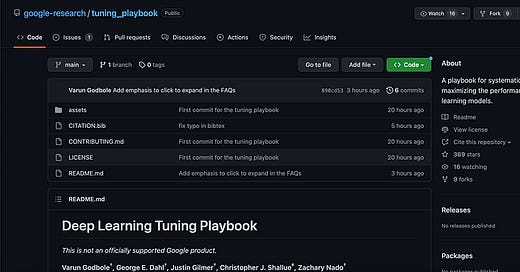Deep Learning Tuning Playbook by Google Brain Engineers
In the slew of mushrooming free advice on machine learning without context and a recipe it is rare that applied use-case guides are…
In the slew of mushrooming free advice on machine learning without context and a recipe it is rare that applied use-case guides are available written by the professionals themselves. A team of scientists from Harvard and Google Brain has joined hands to tackle practical problems, especially hyperparameter tuning.
This document is for engineers and researchers (both individuals and teams) interested in maximizing the performance of deep learning models. Authors assume basic knowledge of machine learning and deep learning concepts.
Their emphasis is on the process of hyperparameter tuning. They touch on other aspects of deep learning training, such as pipeline implementation and optimization, but the treatment of those aspects is not intended to be complete.
It is assumed that machine learning problem is a supervised learning problem or something that looks a lot like one (e.g. self-supervised). That said, some of the prescriptions in this document may also apply to other types of problems.
Deep Learning tuning playbook is an eldorado land for serious engineers looking to optimize their models, available for free on their Github profile. Authors Varun Godbole, George E. Dahl†, Justin Gilmer†, Christopher J. Shallue‡, Zachary Nado have done a great job addressing practical problems at google without actually quoting it.
Chapters include:
Guide for starting a new project
Choosing the model architecture
Choosing the optimizer
Choosing the batch size
Choosing the initial configuration
A scientific approach to improving model performance
The incremental tuning strategy
Exploration vs exploitation
Choosing the goal for the next round of experiments
Designing the next round of experiments
Determining whether to adopt a training pipeline change or hyperparameter configuration
After exploration concludes
Determining the number of steps for each training run
Deciding how long to train when training is not compute-bound
Deciding how long to train when training is compute-bound
Additional guidance for the training pipeline
Optimizing the input pipeline
Evaluating model performance
Saving checkpoints and retrospectively selecting the best checkpoint
Setting up experiment tracking
Batch normalization implementation details
Considerations for multi-host pipelines
A must-read for serious engineers motivated enough to get their hands dirty!
https://github.com/google-research/tuning_playbook#who-is-this-document-for




